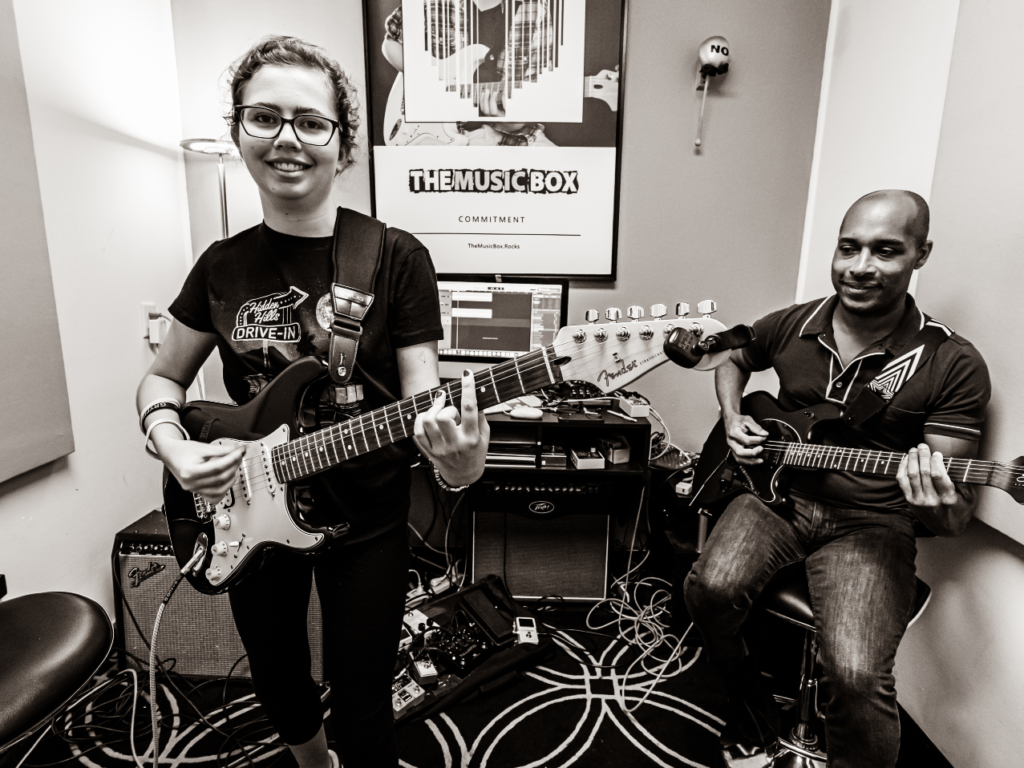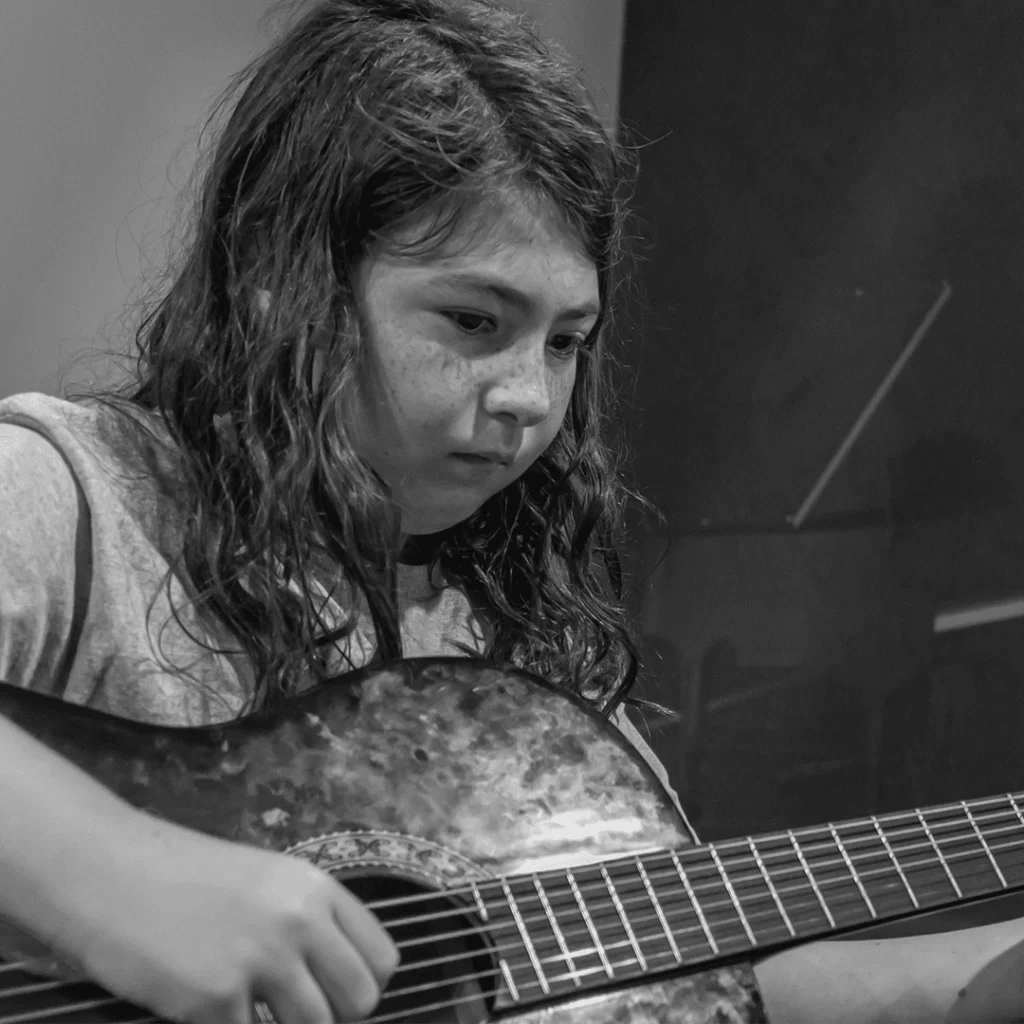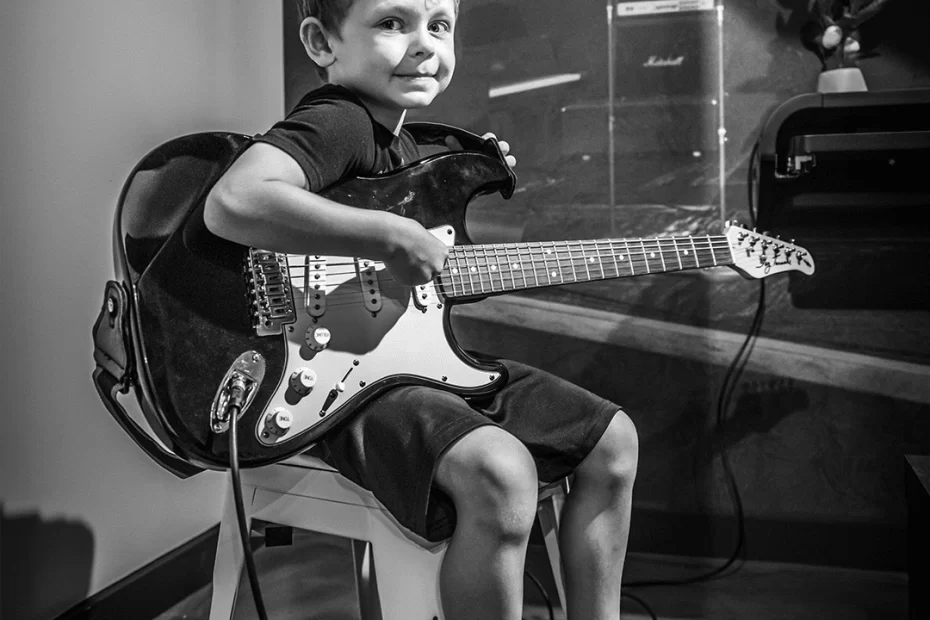Guitarists do far more than just hit the right notes at the right time. The way a note is bent, tapped, or pulled; the way the string is plucked, pinched, or stopped at a certain angle dictates the type of sound that will ultimately be produced.
The methods by which these unique noises are produced are called guitar techniques, and at The Music Box, we’ll help you learn what your guitar idols are doing and implement these techniques in your arsenal.
The Music Box – Tampa’s Premier Guitar School
All music schools teach notes and chords. Some teach songs, but there aren’t many that specialize in transforming beginners into competent rock guitar players. At The Music Box, we leverage decades of combined experience to ensure our students know every trick in the book.
We help our students learn not just how guitar techniques are executed. Our coaches are there to give the students a new perspective on guitar – innovative and often unconventional ways to perform various techniques so that the younger generations can pick up the torch and continue pushing the envelope.
Today, we’ll take you through basic guitar technique lessons that our students are taken through right off the bat. The Music Box coaches are committed to ensuring all parents have access to quality music education for their kids so that they can foster their aspirations and dreams.

Beginner Guitar Techniques 101: Downstrokes & Upstrokes
Many guitar beginners, especially self-taught ones, put too much emphasis on the fretting hand, thinking that a broader reach and the ability to press as many notes in quick succession (in other words, “shred”) equates to guitar skill. That’s simply not the case.
Having taught kids how to play guitar for years, we’ve noticed that most beginners downplay the importance of the first lesson everyone is supposed to learn – how to actually strike the strings.
Downstrokes and upstrokes are the essential “tool” in every guitarist’s skill set. Knowing how to strike each string upward and downward paves the way for all future techniques – from alternate picking and arpeggiated scales to playing chords and shredding.
While most guitar schools spend far too little time on these lessons, The Music Box coaches will invest as many days as necessary to ensure all of our students have a firm grasp on what is the most important guitar technique – proper picking. If you want to see what an average day at The Music Box looks like, join us on our Instagram profile.
Rocking Out with Power Chords
The Music Box is brimming with action and positivity. Our students can’t wait for the next lesson and are inspired to practice at home, so it’s not uncommon for our curriculum to reach chords in a matter of merely a couple of weeks.
Double-note riffs or “power chords” are the building blocks of all rock songs. Since most of our students come to The Music Box after feeling inspired by a local rock band or hearing a powerful tune on the radio, they want to know how these robust, gritty riffs are made and used.
It may sound as simple as “fret two notes, strike two strings”, but in reality, this does not come naturally to many children.
Controlling the length of vibrations, avoiding the strings that do not need to be plucked, and maintaining proper hand-eye coordination at the same time is the key to the power chord technique. Come to our TikTok page and take a look at how some of our students rock out to classic rock songs after just a couple of The Music Box lessons.

Liven Up the Sound by Adding a Vibrato
Two people may play on the same guitar and amp, and yet they won’t sound the same. Some of the most respected guitarists in the world agree on the fact that “sound is in the fingers”, but there’s also the bit of implementing the vibrato technique to give each note its unique personality.
Even though some may argue that vibrato is an intermediate guitar technique, we firmly believe that kids should be aware of it so they can practice it at their own pace. Without vibrato, guitar notes would be barely more than a sequence of different pitches played in a set tempo.
The vibrato technique is a combination of micro-movements. It can be described as a blend of tilts, bends, and whirls, but it’s difficult to define because everyone does it differently.
What we teach to our students is how to “feel” when a vibrato is needed, how to properly deploy it, and when to leave it be. With that knowledge, The Music Box students are already covering some of the greatest rock hits of all time. Come to our Facebook page to check out our students covering Mr. Crowley by Ozzy Osbourne!
Smooth Sliding
Many beginner musicians often waste too much energy plucking every single note they play. Sliding, much like tapping, eliminates the need to pick the strings for a while, letting the plucking hand rest for a second. More importantly, slides give a unique touch to the tone, and when used at the right time, they can sound quite amazing.
Sliding techniques are among the first in our curriculum, mainly because they are as simple as they are necessary for contemporary rock, pop, and jazz playing styles. Once our students understand when and how to slide across the fretboard, they’re ready to tackle more challenging topics, such as arpeggiated scales and more complex chord progressions.
The Journey Begins at The Music Box
It’s never too early to start taking guitar lessons. In fact, experts agree that children as young as 4 years old are more than ready to begin their music education. Our offices are located at 4321 Gunn Highway in Carrollwood, Tampa, Florida, so feel free to come by anytime.
When you’re ready to begin your musical journey at The Music Box, just follow this link, and our staff will help you get started in Tampa’s top guitar school.



